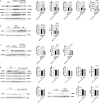Neurosteroid allopregnanolone (3α,5α-THP) inhibits inflammatory signals induced by activated MyD88-dependent toll-like receptors
- PMID: 33637705
- PMCID: PMC7909379
- DOI: 10.1038/s41398-021-01266-1
Neurosteroid allopregnanolone (3α,5α-THP) inhibits inflammatory signals induced by activated MyD88-dependent toll-like receptors
Abstract
We have shown that endogenous neurosteroids, including pregnenolone and 3α,5α-THP inhibit toll-like receptor 4 (TLR4) signal activation in mouse macrophages and the brain of alcohol-preferring (P) rat, which exhibits innate TLR4 signal activation. The current studies were designed to examine whether other activated TLR signals are similarly inhibited by 3α,5α-THP. We report that 3α,5α-THP inhibits selective agonist-mediated activation of TLR2 and TLR7, but not TLR3 signaling in the RAW246.7 macrophage cell line. The TLR4 and TLR7 signals are innately activated in the amygdala and NAc from P rat brains and inhibited by 3α,5α-THP. The TLR2 and TLR3 signals are not activated in P rat brain and they are not affected by 3α,5α-THP. Co-immunoprecipitation studies indicate that 3α,5α-THP inhibits the binding of MyD88 with TLR4 or TLR7 in P rat brain, but the levels of TLR4 co-precipitating with TRIF are not altered by 3α,5α-THP treatment. Collectively, the data indicate that 3α,5α-THP inhibits MyD88- but not TRIF-dependent TLR signal activation and the production of pro-inflammatory mediators through its ability to block TLR-MyD88 binding. These results have applicability to many conditions involving pro-inflammatory TLR activation of cytokines, chemokines, and interferons and support the use of 3α,5α-THP as a therapeutic for inflammatory disease.
Conflict of interest statement
The authors A.L.M., L.A., and I.B. hold a provisional US patent for the mechanisms of 3α,5α-THP action reported in this manuscript. The authors declare no other conflicts of interest.
Figures




Similar articles
-
Neurosteroid [3α,5α]-3-hydroxy-pregnan-20-one enhances IL-10 production via endosomal TRIF-dependent TLR4 signaling pathway.Front Endocrinol (Lausanne). 2023 Dec 21;14:1299420. doi: 10.3389/fendo.2023.1299420. eCollection 2023. Front Endocrinol (Lausanne). 2023. PMID: 38179300 Free PMC article.
-
Endogenous Neurosteroid (3α,5α)3-Hydroxypregnan-20-one Inhibits Toll-like-4 Receptor Activation and Pro-inflammatory Signaling in Macrophages and Brain.Sci Rep. 2019 Feb 4;9(1):1220. doi: 10.1038/s41598-018-37409-6. Sci Rep. 2019. PMID: 30718548 Free PMC article.
-
Inhibition of human macrophage activation via pregnane neurosteroid interactions with toll-like receptors: Sex differences and structural requirements.Front Immunol. 2022 Jul 29;13:940095. doi: 10.3389/fimmu.2022.940095. eCollection 2022. Front Immunol. 2022. PMID: 35967446 Free PMC article.
-
Emerging evidence for endogenous neurosteroid modulation of pro-inflammatory and anti-inflammatory pathways that impact neuropsychiatric disease.Neurosci Biobehav Rev. 2024 Mar;158:105558. doi: 10.1016/j.neubiorev.2024.105558. Epub 2024 Jan 19. Neurosci Biobehav Rev. 2024. PMID: 38244954 Review.
-
Pregnane xenobiotic receptors and membrane progestin receptors: role in neurosteroid-mediated motivated behaviours.J Neuroendocrinol. 2013 Nov;25(11):1002-11. doi: 10.1111/jne.12105. J Neuroendocrinol. 2013. PMID: 24028379 Free PMC article. Review.
Cited by
-
Systemic Administration of the TLR7/8 Agonist Resiquimod (R848) to Mice Is Associated with Transient, In Vivo-Detectable Brain Swelling.Biology (Basel). 2022 Feb 10;11(2):274. doi: 10.3390/biology11020274. Biology (Basel). 2022. PMID: 35205140 Free PMC article.
-
Functional Food Nutrients, Redox Resilience Signaling and Neurosteroids for Brain Health.Int J Mol Sci. 2024 Nov 12;25(22):12155. doi: 10.3390/ijms252212155. Int J Mol Sci. 2024. PMID: 39596221 Free PMC article. Review.
-
GABAergic neuroactive steroid response to sertraline in premenstrual dysphoric disorder.Psychoneuroendocrinology. 2024 Feb;160:106684. doi: 10.1016/j.psyneuen.2023.106684. Epub 2023 Nov 30. Psychoneuroendocrinology. 2024. PMID: 38091917 Free PMC article.
-
Neurosteroid [3α,5α]-3-hydroxy-pregnan-20-one enhances IL-10 production via endosomal TRIF-dependent TLR4 signaling pathway.Front Endocrinol (Lausanne). 2023 Dec 21;14:1299420. doi: 10.3389/fendo.2023.1299420. eCollection 2023. Front Endocrinol (Lausanne). 2023. PMID: 38179300 Free PMC article.
-
PPAR-α Hypermethylation in the Hippocampus of Mice Exposed to Social Isolation Stress Is Associated with Enhanced Neuroinflammation and Aggressive Behavior.Int J Mol Sci. 2021 Oct 1;22(19):10678. doi: 10.3390/ijms221910678. Int J Mol Sci. 2021. PMID: 34639019 Free PMC article.
References
Publication types
MeSH terms
Substances
Grants and funding
LinkOut - more resources
Full Text Sources
Other Literature Sources

